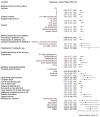Revision surgeries are associated with significant increased risk of subsequent cerebrospinal fluid shunt infection
- PMID: 22333701
- PMCID: PMC3356497
- DOI: 10.1097/INF.0b013e31824da5bd
Revision surgeries are associated with significant increased risk of subsequent cerebrospinal fluid shunt infection
Abstract
Background: The object of this study was to determine whether cerebrospinal fluid (CSF) shunt revision(s) are associated with increased risk of CSF shunt infection, after adjusting for baseline factors that contribute to infection risk.
Methods: This was a retrospective cohort study of 579 children aged 0-18 years who underwent initial CSF shunt placement between January 01, 1997 and October 12, 2006 at a tertiary care children's hospital. The outcome of interest was CSF shunt infection. Data for all subsequent CSF shunt revisions leading up to and including the initial CSF shunt infection, when applicable, were obtained. The likelihood of infection was determined using a Cox proportional hazard model accounting for patient characteristics and CSF shunt revisions, and is reported using hazard ratios (HR) with 95% confidence intervals (CI).
Results: There were 123 children who developed infection. Baseline factors independently associated with hazard of infection included age 0 to <6 months at CSF shunt placement (HR 2.4, 95% CI: 1.02-6.7) and myelomeningocele (HR 0.4, 95% CI: 0.2-0.8). Controlling for baseline factors, the risk of infection after shunt revision was significantly greater than at the time of initial placement (HR 3.0, 95% CI: 1.9-4.7), and this risk increased as numbers of revisions increased (≥2 revisions HR 6.5, 95% CI: 3.6-11.4).
Conclusions: Although younger age is associated with increased hazard of infection, subsequent CSF shunt revision significantly increases infection risk.
Conflict of interest statement
Similar articles
-
Risk factors for first cerebrospinal fluid shunt infection: findings from a multi-center prospective cohort study.J Pediatr. 2014 Jun;164(6):1462-8.e2. doi: 10.1016/j.jpeds.2014.02.013. Epub 2014 Mar 21. J Pediatr. 2014. PMID: 24661340 Free PMC article.
-
Association of intraventricular hemorrhage secondary to prematurity with cerebrospinal fluid shunt surgery in the first year following initial shunt placement.J Neurosurg Pediatr. 2012 Jan;9(1):54-63. doi: 10.3171/2011.10.PEDS11307. J Neurosurg Pediatr. 2012. PMID: 22208322 Free PMC article.
-
Reduction in CSF shunt infection over a 10-year period associated with the application of concentrated topical antibiotic powder directly to surgical wounds prior to closure.J Neurosurg Pediatr. 2015 Dec;16(6):648-61. doi: 10.3171/2014.12.PEDS13675. Epub 2015 Sep 18. J Neurosurg Pediatr. 2015. PMID: 26382185
-
A multicenter study of factors influencing cerebrospinal fluid shunt survival in infants and children.Neurosurgery. 2008 May;62(5):1095-102; discussion 1102-3. doi: 10.1227/01.neu.0000325871.60129.23. Neurosurgery. 2008. PMID: 18580807
-
Shunt implantation: reducing the incidence of shunt infection.J Neurosurg. 1992 Dec;77(6):875-80. doi: 10.3171/jns.1992.77.6.0875. J Neurosurg. 1992. PMID: 1432129 Review.
Cited by
-
The survival time of the ventriculo-peritoneal-shunt in children with hydrocephalus is dependent on the type of valve implanted.Pediatr Surg Int. 2023 Feb 13;39(1):119. doi: 10.1007/s00383-023-05395-0. Pediatr Surg Int. 2023. PMID: 36780089 Free PMC article.
-
Molecular Characterization of Microbiota in Cerebrospinal Fluid From Patients With CSF Shunt Infections Using Whole Genome Amplification Followed by Shotgun Sequencing.Front Cell Infect Microbiol. 2021 Aug 20;11:699506. doi: 10.3389/fcimb.2021.699506. eCollection 2021. Front Cell Infect Microbiol. 2021. PMID: 34490140 Free PMC article.
-
Efficacy and safety of the Miethke programmable differential pressure valve (proGAV®2.0): a single-centre retrospective analysis.Childs Nerv Syst. 2021 Aug;37(8):2605-2612. doi: 10.1007/s00381-021-05162-3. Epub 2021 May 21. Childs Nerv Syst. 2021. PMID: 34021371 Free PMC article.
-
Ventriculoperitoneal shunt infection: insights from a single-center comparative analysis.Neurosurg Rev. 2025 Jan 21;48(1):69. doi: 10.1007/s10143-025-03234-5. Neurosurg Rev. 2025. PMID: 39833589
-
Risk factors for first cerebrospinal fluid shunt infection: findings from a multi-center prospective cohort study.J Pediatr. 2014 Jun;164(6):1462-8.e2. doi: 10.1016/j.jpeds.2014.02.013. Epub 2014 Mar 21. J Pediatr. 2014. PMID: 24661340 Free PMC article.
References
-
- Browd SR, Gottfried ON, Ragel BT, Kestle JR. Failure of cerebrospinal fluid shunts: part II: overdrainage, loculation, and abdominal complications. Pediatr Neurol. 2006 Mar;34(3):171–176. - PubMed
-
- Browd SR, Ragel BT, Gottfried ON, Kestle JR. Failure of cerebrospinal fluid shunts: part I: Obstruction and mechanical failure. Pediatr Neurol. 2006 Feb;34(2):83–92. - PubMed
-
- Garton HJ, Kestle JR, Drake JM. Predicting shunt failure on the basis of clinical symptoms and signs in children. J Neurosurg. 2001 Feb;94(2):202–210. - PubMed
-
- Simon TD, Riva-Cambrin J, Srivastava R, Bratton SL, Dean JM, Kestle JR. Hospital care for children with hydrocephalus in the United States: utilization, charges, comorbidities, and deaths. J Neurosurg Pediatrics. 2008 Feb;1(2):131–137. - PubMed
-
- Whitehead WE, Kestle JR. The treatment of cerebrospinal fluid shunt infections. Results from a practice survey of the American Society of Pediatric Neurosurgeons. Pediatr Neurosurg. 2001 Oct;35(4):205–210. - PubMed
Publication types
MeSH terms
Grants and funding
LinkOut - more resources
Full Text Sources


